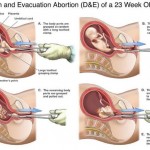No woman expects to have an abortion, but one of every three women in the US will have an abortion by the time she is 45 years old. Â Abortion care is disproportionately sought by women facing difficult financial circumstances and women of color in the US. Second-trimester abortions are no different in that respect. Abortion in the second trimester – from 13 to 24 weeks – is generally performed using a procedure called Dilation & Evacuation (D&E). The D&E procedure is different from a 1st trimester abortion in a number of ways. What is different is that a woman seeking a second-trimester abortion faces greater challenges than one obtaining a first-trimester abortion, as fewer doctors offer the service, they are substantially more expensive than first-trimester abortions, and they are often two day procedures.
 In general, women who have second-trimester abortions are somewhat more likely to be disadvantaged than women who have first-trimester abortions. Women who have second-trimester abortions:
In general, women who have second-trimester abortions are somewhat more likely to be disadvantaged than women who have first-trimester abortions. Women who have second-trimester abortions:
- Are more likely to be teenagers (29% v.19%);
- Have less education on average (30% of women who have second-trimester abortions have not completed high school as compared with 19% of women who have had a first-trimester abortion);
- Have a lower median income (33% are at 100% or less of poverty line as compared with 26% of women who have a first-trimester abortion); and
- Are more likely to be African-American (31% of first-trimester patients are African-American whereas 38% of second-trimester patients are African- American). The percentage of second-trimester patients drops slightly among Caucasians and Latinas, stays the same for Asian-American women and goes from 1 to 2 percent among Native American non-Hispanic women.
Clearly, more can and should be done to expand access to preventive services – including education and contraceptive options – as well as provide more resources to those women who are pregnant and want to carry their pregnancy to term. But each person’s circumstances are unique and there are many different reasons a woman or a couple may decide to end a pregnancy, even after the first trimester.
Research suggests that late detection of pregnancy, cost and access barriers, and difficulty deciding what to do are some of the factors that cause women to seek a second-trimester abortion. For example:
- In one study, women under the age of 18 years took longer than older women to acknowledge pregnancy symptoms and take a pregnancy test.
- Poor women were twice as likely as wealthier women to experience delays due to “making arrangements.â€
- A delay in confirming pregnancy may be associated with obesity, abuse of drugs or alcohol, a fear of abortion, or being unsure of one’s menstrual cycle.
- Research also shows that having had a prior second-trimester abortion is a strong predictor for second-trimester abortion, suggesting some underlying factors in a woman’s life that limit her ability to take control of a situation.
- Women are twice as likely to cite either a possible health problem with the fetus or her own health as a reason for terminating in the second trimester as compared with those in the first trimester.
- A case study report suggests that some women delay because they are conflicted and take more time to resolve whether they can carry a pregnancy term, place their child for adoption or end their pregnancy.
 What to Expect
- When making your appointment – expect the staff person to be professional, knowledgeable, and nice.
- All medical appointments begin with paperwork – medical history, information sheets and consent forms. Be sure to have your ID and health insurance information with you.
- Laboratory tests will also be part of your day. You may have a pregnancy test, anemia screening, and Rh type. Expect to give a urine and/or blood sample.
- Later abortion requires an ultrasound to accurately date the gestational age of the pregnancy. This is done at the beginning of your appointment process to determine whether you are eligible for an abortion at the facility.
- Expect some private time with a staff person to review your medical history, birth control plan, and other papers. This is also a time for you to ask questions and raise any concerns you may have.
- To minimize strain to your cervical muscle you may undergo gradual dilation that could take a few hours or happen overnight. Your abortion provider has a variety of products to choose from to achieve gradual dilation and will select the one that is most appropriate for your situation.
- Later that day or the next day, your abortion will take place in an exam or procedure room with the physician and an assistant. If you are using general anesthesia there will also be a professional administering those medications.
- After the abortion you will have up to an hour to rest and recover with a nurse or medical assistant to take care of you.
- Lastly, you will be encouraged to schedule a follow-up visit within 2 to 3 weeks. This is a wonderful opportunity to make certain you have healed properly, to continue your birth control plan, and even get a pap test.


